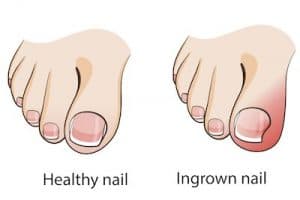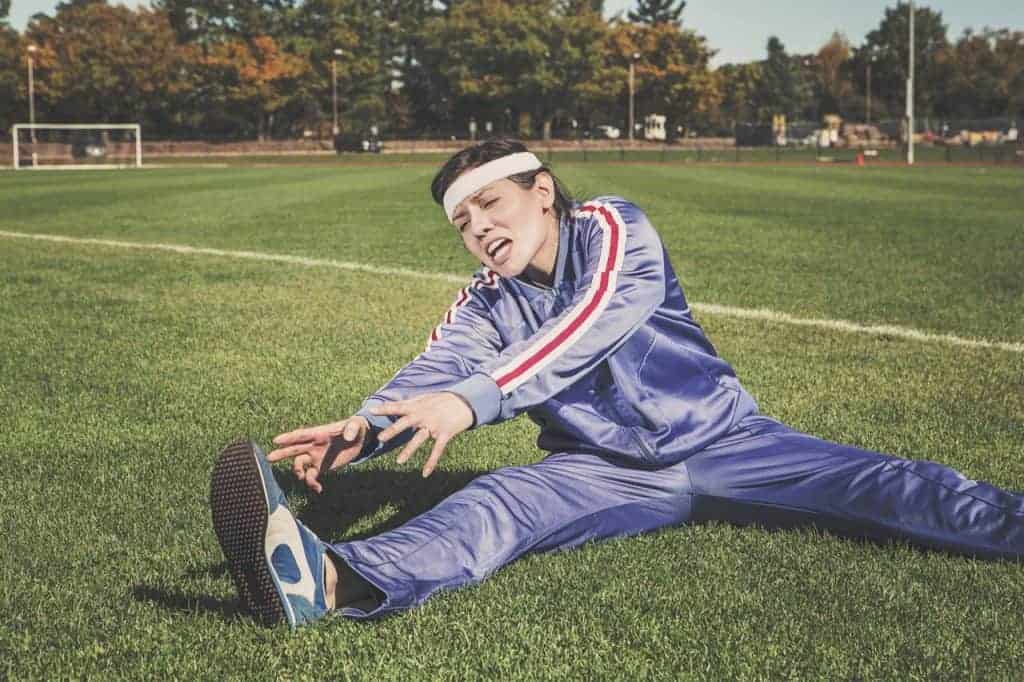
Blog, Kids Feet

Knee pain in kids
“Knee pain almost exclusively only affects active kids,” says sports podiatrist and founder of A Step Ahead Foot + Ankle Care Dr Brenden Brown.
“In the majority of cases the knee pain will be related to a specific period of activity.
“Sometimes you have to look back 12 hours before the pain starts to pinpoint the activity that caused it. For example, a child might be sore and suffering from a really painful knee on Sunday yet because they didn’t hobble off the footy field after their game on Saturday the parents don’t relate the pain to playing football.”
Causes of kids’ knee pain
Dr Brenden says knee pain in children is predominantly caused by Osgood-Schlatter disease.

What is Osgood-Schlatter disease?
Osgood-Schlatter disease is characterised by a painful lump just below the kneecap.
According to the American Academy of Orthopaedic Surgeons, ‘Osgood-Schlatter disease most often occurs during growth spurts, when bones, muscles, tendons, and other structures are changing rapidly. Because physical activity puts additional stress on bones and muscles, children who participate in athletics—especially running and jumping sports—are at an increased risk for this condition. However, less active adolescents may also experience this problem.’
Treating knee pain in kids
“The most common treatment approach by practitioners is stretching or advising the child to stop playing sport.
“I disagree,” says Dr Brenden.
“Telling kids to stop playing sport is not a treatment modality. It’s simply avoiding the cause of the pain. Once they start activity again, BOOM the pain re-appears!
“Similarly, stretching alone will not, in most cases, cure the underlying problem. I see children who are given stretching routines by their healthcare professionals time and time again, season after season. If knee pain is an ongoing problem for the child, we should be evaluating their foot posture in order to find the core problem and a positive long-term solution.”
Dr Brenden adds, “There are far too many viable treatment options available which can address the underlying issue of knee pain and keep children active.
“Advising a child to stop playing sport is no longer necessary and is in fact detrimental to child’s long-term health”

Tips to prevent knee pain in kids
—Warm up properly. Before you “warm up” with a jog, try walking at a moderate to brisk pace 4 times around the football field (8 times around a netball court). Start slow, increase as you progress—NEVER run!
—Ensuring you’re wearing the right footwear can help protect the knees. Wear good, supportive, sports-specific shoes (not the trendiest runners you can find!).
“Choosing appropriate footwear that’s specific to the sport being played would likely reduce the amount of foot-related injuries we see by at least 25%,” says Dr Brenden.
—Work on improving the leg muscle strength and flexibility. Isometric strength exercises are readily accessible and can be performed anywhere—even when in pain!
Related articles:
Warming up for sports…why bother?
What’s causing your child’s heel pain?
Common kids’ foot complaints
ABOUT US
A Step Ahead Foot + Ankle Care is one of Sydney’s leading foot and ankle clinics. Principal podiatrist and founder of A Step Ahead Dr Brenden Brown (AKA Dr Foot) has been taking care of people’s feet for more than 20 years.
With a background in sports medicine and having served as a former president of the Australasian Podiatry Council, Brenden is a wealth of information when it comes to foot and ankle care.

Blog, Heel Pain, Sports Care

Isotonic versus isometric movements for heel pain
“It’s becoming much more widely recognised and accepted that stretching is not good for tendon pain. Instead, we should be looking at building muscle and tendon strength,” says sports podiatrist and founder of A Step Ahead Foot + Ankle Care Dr Brenden Brown.
Professor Jill Cook, from La Trobe University’s Sport and Exercise Medicine Research Centre, has a wealth on knowledge about tendon injury. She says, “Aside from the load on your tendon when you play sport, there are compressive loads on your tendon when it is at its longest length, adding stretching to most tendons only serves to add compressive loads that we know are detrimental to the tendon. Stretching while you are standing can be especially provocative to your tendon.”
Isotonic Vs isometric
Isotonic contractions generate force by changing the length of the muscle and tendon
[For example, going up and down on your toes (calf raise)]
Isometric contractions generate force without changing the length of the muscle or tendon.
[For example, going up on your toes and holding in the upward position]
“People are familiar with isotonic exercises, particularly for the pain associated with Achilles Tendinopathy. There was a well know technique called the ‘Alfredson technique’, in which people would stand on edge of a step and lower their heels up and down over the back of step.
“This has long been therapists’ go-to exercise, for heel pain in particular. However, we now know this only serves to irritate and aggravate this condition, yet it doesn’t have to be so,” says Dr Brenden.
“We need to graduate the building of strength and to do this we start with isometric movements, rather than rushing straight into isotonic movements.”
Isotonic versus isometric movements for heel pain
For the majority of people the process involves moving from isometric holds with quite heavy loads of body weight or beyond.
After we’ve developed significant load and reduced the symptoms, including pain, we begin to move into the next phase, which includes isotonic movements.
From there we move to more functional strength exercises that are specific to your activity or sport.
This means the exercises can’t just be calf raises, they need to be aligned to the individuals activity so that their tendon is ready for the activity they’re about to re-enter into.
“I like to refer to isometric loading as ‘progressive muscle loading’. Gradual loading is such a vital part; if people are not progressing they won’t get back healthy strong tendons,” says Dr Brenden.
Common mistakes people make when performing isometric exercises
- They don’t loading heavy enough. Remember, tendons are built for strength so they can take quite a bit of weight.
- They don’t load for long enough
- They don’t progress. Instead they plateau out. At all times, on a day-to-day basis moving through to a week-to-week basis you should be progressively increasing time and load to develop the tendon’s and muscle’s strength and capacity.
Related articles:
Warming up for sports—why bother?
10 things you should know about heel pain
A Step Ahead Foot + Ankle Care is one of Sydney’s leading foot and ankle clinics. Principal podiatrist and founder of A Step Ahead Dr Brenden Brown (AKA Dr Foot) has been taking care of people’s feet for more than 20 years.
With a background in sports medicine and having served as a former president of the Australasian Podiatry Council, Brenden is a wealth of information when it comes to foot and ankle care.

Blog, Uncategorized

Ingrown toenail surgery—is it right for you?
What does ingrown toenail surgery involve?
Surgery to address an ingrown toenail (onychocryptosis) involves removing the bothersome nail and applying a chemical to prevent the nail from growing back.
In some instances it may be necessary or most beneficial to remove a small section of nail at one or both sides, but on the odd occasion the entire nail (total nail avulsion) will be removed.
It is a quick and simple procedure than is essentially pain free as it is performed with an injection of local anaesthetic.
Following surgery the toe is dressed and generally speaking there is little, if any, pain or discomfort. You may expect some throbbing that night or discomfort but this is most often managed well with paracetamol.
When is toenail surgery the best option?
Ingrown toenail surgery should not be considered first-line treatment for an ingrown toenail. It can be considered when:
- Other non-surgical methods have been exhausted
- The nail is involuted or curved
- Ingrown toenail is problematic, painful or recurring
- You understand the implications and potential complication of surgery
- You have discussed any concerns with your podiatrist
What are the advantages of clinic-based toenail surgery?
- No time in hospital
- No Sutures / stitches required – all completed under the nail plate
- No more recurrent ingrown toenails
- Pain free
- Minimal time off work
- Reduced episodes of infection and lesions (weeping, bleeding)
- In the majority of cases, ingrown toenail surgery is very successful
Dr Brenden Brown, podiatrist and founder of A Step Ahead Foot + Ankle Care, says, “Nail surgeries are not new for podiatrists; we perform them on a regular basis. It is part of our training at University so we are well versed in this surgery. It is carried out in our clinic and, due to our high level of training, is a fairly simple procedure.
“I often describe this surgery as ‘relatively pain free’. It is wrong to say any surgical procedure is ‘completely pain free’ but as procedures go our patients report very little, if any, pain. In fact, patients are frequently surprised at just how pain free it actually is!
“This procedure can certainly be of benefit and is recommended for patients who have a history of infection or recurrent ingrown toenails. It’s also very helpful for patients with involuted or very curved nails and toenails with areas that seem to catch the skin on the side of the nail.
“Patients often suffer from an ingrown toenail for many years with little idea where to go to for help.
“The days of painful surgeries with patients regularly experience nail re-growth are gone. It’s also important to remember that what you see on YouTube and other social media sites is often the ‘most horrible’ and ‘most atrocious’. If it wasn’t so gruesome you probably wouldn’t have been so motivated to watch and it likely would have got the “views” it did!
Related articles:
5 hacks to keep ingrown toenails at bay
ABOUT US
A Step Ahead Foot + Ankle Care is one of Sydney’s leading foot and ankle clinics. Principal podiatrist and founder of A Step Ahead Dr Brenden Brown (AKA Dr Foot) has been taking care of people’s feet for more than 20 years.
With a background in sports medicine and having served as a former president of the Australasian Podiatry Council, Brenden is a wealth of information when it comes to foot and ankle care.
Got a question? Check out our Instagram profile #AskDrFoot
Tune into our Facebook page for regular live videos and updates on the latest foot and ankle advice from the experts.

Blog, Uncategorized

5 hacks to keep ingrown toenails at bay
What causes an ingrown toenail?
Ingrown toenail (known medically as onychocryptosis) is a condition where the edge of the toenail (most commonly on the big toe) pierces or catches on the skin as it grows up.
MYTH: Nails only grow upwards they do not on any occasion grow outwards towards the side.
There are several causes of an ingrown toenail but probably the most widespread is poor toenail-trimming technique. Cutting down the side of the nail is a major no-no. Why? Because even the smallest spike of nail can grow up and penetrate, or get caught on, the skin.
The ingrown slither of nail acts like a splinter; the skin around it thinks it’s a foreign body and becomes inflamed and infected.

5 hacks to prevent ingrown toenails
- Clip with caution. Trim toenails straight across. DO NOT cut down the sides of the nail and refrain from cutting nails too short
- Refrain from ripping the nails down the sides. We have all done this! You cut but you can’t get that last bit of nail, so you abandon the clippers and rip the last piece down the side. This leaves a sharp spike, which may not be painful now but in following days it will grow upwards and catch on the skin piercing it creating the subsequent infection and PAIN!
- Ditch footwear that is too tight or constricts the toes from moving. This can push the nail into the skin causing irritation and infection
- Steer clear of unqualified people offering to remove ingrown toenails. While this may sound somewhat self-serving, there are an increasing number of nail salons offering to perform this sort of work. Removing the nail breaks the skin barrier, which can easily become infected. Whilst your podiatrist makes it look easy that is because it’s what they have been trained to do and complete on a regular basis.
- Adhere to best-practice foot care by keeping feet clean and dry to avoid weak, splitting nail and fungal infections.
How to fix ingrown toenails — at home
To treat an ingrown toenail at home you can try: Cutting the nails straight across and applying an antibiotic cream to help reduce the risk of infection and subsequent inflammation. You can also use a nail file to round the corners!
MYTH: Cutting a V in your toenail will not make it grow inwards; nails only grow upwards. While the V may look like it’s closing in, this is an illusion as you are trimming the top of the V, making it appear like the V is getting smaller over time.
Applying a small piece of cotton wool between the ingrown nail and the skin can help life the nail, hopefully clearing it and preventing the nail from piercing the skin again.
Avoid wearing high heels, pointed or tight fitting shoes as these can place pressure on the affected area, potentially delaying healing.
The professional approach
Dr Brenden Brown, podiatrist and founder of A Step Ahead Foot + Ankle Care, says, “If the toenail turns into a monster and becomes red, angry or infected—It’s definitely time to seek professional advice.
“A podiatrist can easily treat an ingrown toenail by removing the troublesome spike of nail. In most cases this is a quick (takes minutes) and simple procedure, which is completely painless.
“Following the removal of the nail spile, the toenail area is cleaned and, if infection has been present, the toe will be dressed.
“In extreme cases, toenail surgery may be required. This will generally only happen if the patient has a repeated history of recurrent in grown nails or if the nails shape means it requires removal of that section, such as when it is involuted or excessively curved.
“It is more rare than most people think to remove a whole nail as we can manage these well conservatively”
Related articles:
Ingrown toenail surgery—is it right for you?
ABOUT US
A Step Ahead Foot + Ankle Care is one of Sydney’s leading foot and ankle clinics. Principal podiatrist and founder of A Step Ahead Dr Brenden Brown (AKA Dr Foot) has been taking care of people’s feet for more than 20 years.
With a background in sports medicine and having served as a former president of the Australasian Podiatry Council, Brenden is a wealth of information when it comes to foot and ankle care.
Got a question? Check out our Instagram profile #AskDrFoot
Tune into our Facebook page for regular live videos and updates on the latest foot and ankle advice from the experts.

Blog, Sports Care

Warming up for sports—why bother?
“Warm-ups have the ability to help prepare the muscles for activity. However, what’s changed is that we now question many ‘traditional’ warm-up methods; evidence suggests that static stretching probably shouldn’t be part of most people’s warm up routine,” says founder of A Step Ahead Foot + Ankle Care Dr Brenden Brown.
“The days of a few quick hamstring stretches followed by a run around the field are long gone. Modern warm-ups are more cleverly designed; they need to be more specific to the sport we’re playing or the activity we’re embarking on.”

The benefits of warm-ups
“Preparing the body for participation in sports by warming up, will enhance the maximal performance and reduce the risk of injury! This is a sentence I often find myself repeating over and over again to my young patients,” says Dr Brenden.
“The Netball World Cup was a great example of how warming up is directly linked to injury prevention and optimum performance. The public was able to see first hand the amount of time the best teams in the world spend on warming up before games.
“Warming up improves blood flow to the heart, increases the muscle temperature and makes muscles more pliable.
“Cold or less pliable or elastic muscle works harder to accommodate a given load and will be more resistant to sudden stretch. Less pliable muscle tissue is also more susceptible to overuse injuries.
“No matter what the sport or activity is, players can begin their warm-up by walking a couple of laps of the soccer field or court. Increase the pace on the second lap to turn it in to a brisk walk but don’t jog or run.
“As you walk you’re infusing the tissue and muscles with blood to gently warm up the body. At the end of a gentle warm-up your muscles are ready to be used.”
The ‘right’ kind of netball warm-up
“I continue to see kids doing two types of warm-ups. They either run from one end of the netball court to the other and that’s it or they go back to the classic—are dare I say outdated—routine involving calf stretches, hamstring stretches, touching toes and throwing the ball into the hoop.
“If we take netball as an example, the warm-ups need to be specific to the sport. Most netballers need to be doing lots of side-to-side movements, twists, turning and cutting movements.
“This might include doing the grapevine across the court, side-to-side stepping, moving up to side-to-side hoping and jumping. Standing still, pointing the toe and rotating the ankle is also useful as part of a warm-up.
“The warm-up routine needn’t take half an hour but it should take approximately 10-15 minutes.”

To stretch or not to stretch—this is the question!
Dr Brenden explains, “By stretching out a muscle and holding it there (static stretching) we’re pushing the tissue past where it needs to go, which could do more harm than good.
“This type of stretching is also not sports specific. However, stretching doesn’t always mean stretching out a muscle and holding it there.
“Dynamic stretches differ from the norm in that they stretch the body through movement. So instead of holding the muscle in a static stretched-out position, you move gradually through the movement.
“At best, I’d call this a light stretch. There should be no risk of over-stretching the muscles.”
8 reasons to warm up
- Increases range of movement
- Warms up muscles in prepares for activity
- Increases fluid production to lubricate joints
- Triggers the neural pathways between your brain and your muscles
- Improves reaction and response time
- Reduces risk of injury
- Potential to improve performance
- Helps improve recovery time
Related articles:
Winter sports’ greatest enemy….ankle sprain
Your guide to rock-solid ankle stability
A Step Ahead Foot + Ankle Care is one of Sydney’s leading foot and ankle clinics. Principal podiatrist and founder of A Step Ahead Dr Brenden Brown (AKA Dr Foot) has been taking care of people’s feet for more than 20 years.
With a background in sports medicine and having served as a former president of the Australasian Podiatry Council, Brenden is a wealth of information when it comes to foot and ankle care.



















 Dr Brenden’s White paper report on the “6 Reasons You Won’t Beat Heal Pain” outlines what’s stopping you from beating this and tips on how to stop it in its tracks!
Dr Brenden’s White paper report on the “6 Reasons You Won’t Beat Heal Pain” outlines what’s stopping you from beating this and tips on how to stop it in its tracks!